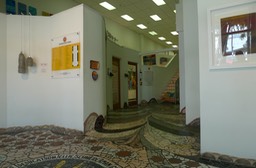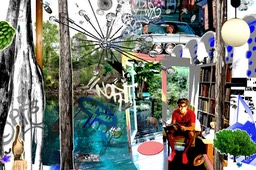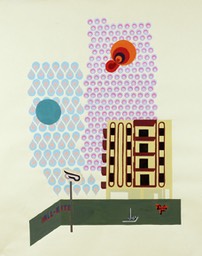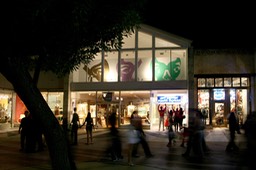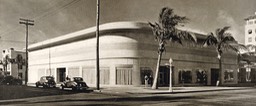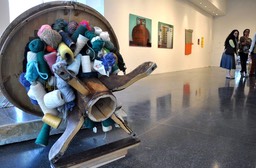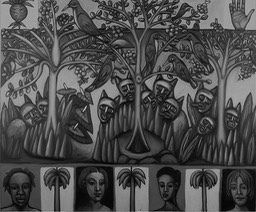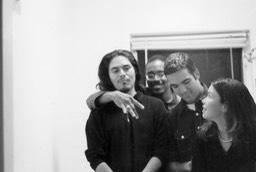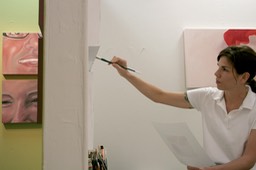Listen to commentaries from ArtCenter South Florida leaders and participants
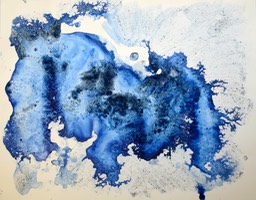
Xavier Cortada, Drygalski; sea ice from the Antarctica’s Ross Sea, and mixed media on paper; 12 inches x 9 inches; 2007; created onsite at McMurdo Station, Ross Island, Antarctica; courtesy the artist
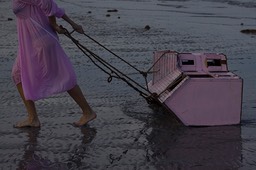
Amalia Caputo, La Casa (de Hestia); 2009; giclée print; courtesy the artist and ArtCenter/South Florida

Cat Del Buono, Now I'm Beautiful! 2012; still from video; courtesy the artist and ArtCenter/South Florida
Thirty Years on the Road at ArtCenter South Florida
by George Fishman
It was once a mangrove forest, cleared by developer Carl Fisher from ocean to bay. It is perhaps destined to again disappear – this time under rising seawater. But Lincoln Road has always been a work of transformation: a motorway lined with furriers, luxury car dealers and fashion houses; an alluring Lapidus-designed pedestrian corridor, studded with alluring fountains and gardens; a wasteland of shuttered storefronts and decrepitude. And, as it has been for the past three decades, home base for the Art Center South Florida (AC/SF).
Spearheaded by charismatic ceramic artist Ellie Schneiderman, the AC/SF was born with a vision of providing low-cost studios, exhibition spaces, camaraderie and community engagement. At that it has succeeded, but it spurred so much more.
In concert with the Art Deco preservation movement and Wolfsonian and Bass Museums, the Center was the true beginning of not exclusively Lincoln Road’s contemporary renaissance, but also Miami Beach’s renewal. The Miami City Ballet, New World Symphony, Art Basel and untold millions in retail commerce owe much to the Center.
THE BEGINNINGS
Jane Harris was among the band of artists who rented studios along the string of storefronts leased and sublet by the Center on the 800, 900 and 1000 blocks of the Road, beginning in 1984. “The AC/SF provided the opportunity for me to make art night and day within a creative community in a tropical paradise, an incubator for ideas and like-minded friendships,” Harris recalls. Hers was among many commentaries collected for the Anniversary celebration. The creative opportunity remains, but in a much different setting today, and as it celebrates its 30th anniversary, the Center is preparing for another dramatic change.
For AC/SF, turning 30 marks a major transition into “adulthood,” especially with the $88 million sale of its anchor 800 Lincoln Road building and the big decisions that engenders. It is one of three properties that the Art Center astutely purchased during its early years, thus assuring its status as an owner, not just a renter. As upscale chain stores and restaurants drove up rents, the center was still able to provide affordable studio space in its own buildings.
The anniversary celebration, in which the work of nearly 150 former and current studio artists will be exhibited, is not limited to the Center’s own galleries, windows and vitrines, but also will utilize – by longstanding arrangement – Walgreens’ storefront windows at four Beach locations.
Close to 1,000 artists are “alumni” of the ongoing juried studio program of below-market rentals – an enormous talent pool from which to select.
CURATING AN EXHIBITION
Internationally renowned artist/curator Edouard Duval-Carrie was charged with choosing the works to be exhibited, working closely with artistic director, Susan Caraballo. "Probably, he joked, “they thought I was the most conciliatory artist that ever showed up there."
Duval-Carrie had not made studio visits on the Road for a decade. Caraballo took him on tour. He was deeply impressed by the “seriousness” of artists and their production.
Born in Haiti, Duval-Carrie rented one of the Center’s studios soon after arriving in Miami. It became his point of entry into the city’s artistic life. He remembered his own start, when an out-of-the-house studio was a critical step in establishing a consistent practice and identifying as a professional.
Initially, Caraballo’s role was to bring the work of as many alums as possible to Carrie’s attention. This began about 18 months ago, organizing and updating a contact database.
Director, Maria del Valle, Caraballo and Center staff implemented a submission process, and the curators reviewed hundreds of images and proposals – taping printouts to the walls and also using desktop software. They wanted to pay respect to the artistic legacy, but also, as Del Valle said, “give a glimpse of the new artists and new artistic direction.” Ultimately, 110 or 115 artists will participate in the anniversary exhibitions, including approximately 40 artists representing themselves in their studios and hallways.
“My idea was to be as inclusive as possible; hers was to continue to raise the bar,” Duval-Carrie said regarding their collaboration. Caraballo said she shared his inclusive vision, but, “We would go to see an artist and he would say, ‘Oh I want to include four of these’, and I would be ‘We can't fit four of these,’ so there was always that bit of a dynamic of, ‘No, we have to select [just] one.’ Or, ‘We can't make a decision until some of the other work is selected.’”
HANGING THE SHOW
On a recent afternoon, The Richard Shack Gallery at 800 Lincoln Road was a hive of activity, as students in orange t-shirts were engaged in a documentary project, soliciting written and audio-visual comments from the public. Hanging the anniversary exhibition there would have to wait.
Caraballo took a break from installing the Project 924 exhibition in its second-floor glass-fronted gallery. “It’s about nature encountering urbanism in some way, and it's really coming together today,” she said, “because we’re installing it today!”
The synergies emerge as pieces are tentatively placed together. Among those with nature themes are Xavier Cortada’s Atlantic Sea Ice Series: watercolors the artist created at McMurdo Station during a National Science Foundation project fellowship, using sea ice, glacier and sediment samples. Much closer to the ecology of South Beach was the artist’s Reclamation project.
As one component of a complex reforestation program, Cortada, a 2010-11 studio alumnus and environmental activist, enlisted dozens of Lincoln Road artists and merchants to hang live mangrove seedlings – suspended in cups of water – in their storefronts, along with information about his community-based replanting project.
Sitting under the umbrella of one of Lincoln Road’s chic eateries, it’s hard to conceive of the dilapidation, boarded-up storefronts, shabbiness and vagrancy that made up the “charm” of the early days.
Ceramic artist Schneiderman is acknowledged as the Center’s founder. Fortunately, she and her backers – notably attorney I. Stanley Levine (a generous and prodigious charity fundraiser) – were familiar with the Soho dynamic: artists as both foot soldiers and subsequent victims of gentrification. Instead, through concerted fundraising, the Center purchased and rehabilitated three anchor properties. One of those rehabs includes Carlos Alves’ spectacular “inundation” of vibrant ceramic mosaics in the 800 Building. Close friend, the late Marina Fernandez, created idiosyncratic stained-glass inserts animating the iron handrails.
“Lincoln Road isn’t Dadeland,” Schneiderman said to a reporter in 1990, when approximately 80 artists rented subsidized studios in 22 storefronts. “Buying a painting is lot different from buying a pair of shoes. However, the artists are starting to develop a following, and each year it’s getting better.” Miami City Ballet, Alliance Film CoOp, Books & Books, Wet Paint Café, Barbara Gillman Gallery and the re-opened Colony Theater were among the neighbors making it better.
HISTORY THROUGH TABLOIDS
Three “newspapers” augment the anniversary documentation process. Each marks a decade; each was uniquely designed by a studio alum. These tabloid-format publications will be given away.
Charo Oquet’s When the artists owned the Road contains her reminiscences on the first decade, during which she transitioned from figurative painting to ceramics and printmaking to performance and installation. She helped establish the Center’s printmaking studio and ran a summer youth program. “In that period, for my performance photographs, I began to dress myself as a powerful Mambo (priestess of the voodoo religion) against a backdrop of different altars that I created.”
Oquet compiled mostly wistful comments from artist colleagues – among them, ceramic artist James Herring, who also organized freewheeling shows at Ground Level gallery and ClaySpace. He’s now curating an anniversary ceramics show. Oquet’s graphic timeline presents scores of artists (many prominent names) clustered around the Center’s addresses with photos and news bulletins.
Paul Berry, a member of the Alliance Film/Video Co-Op, described the warren of spaces at 800. “Once inside the door, the cluttered studios seemed to grow out of proportion to their numbers, like Alice’s Wonderland, and then you discovered the stairs, and it took on the quality of a delightfully disorienting three-dimensional labyrinth.”
William Cordova’s photo-illustrated diary-like presentation, Stairway to Heaven represents the years 1995 to 2005 in a bittersweet, but spare narrative. He affectionately recalls the artists and associated enterprises that nurtured the generous creative spirit comprising the Center’s great treasure and legacy. Many of the artists whom he met, collaborated and exhibited with have since made their marks far and wide – as has Cordova.
He credits those individuals and institutions who crucially promoted the talent of AC/SF artists, but also sadly documents the closing of The Alliance Theater and Video Co-Op, writing, “The Lincoln Road landscape was changing rapidly... out were Bianca Lanza Gallery, Clay Space, Barbara Gillman Gallery, Gutierrez Fine Arts and so many others. In was Crate & Barrel, The Gap … that shifted the presence and tenor of what Miami Beach used to be.”
Kristen Thiele painted in the 810 Building for 10 years. Her husband Frank Casale avidly photographed on the Road. For her untitled tabloid, she created a scrapbook, arranging images within a playful framing scheme of her home’s décor, where many colleagues’ works hang. “I live with them every day..... and I am lucky to have had that experience and to have met these wonderful people and makers of art!”
WHAT'S NEXT?
Maria del Valle has been Center director for nearly three years. With her staff – she has augmented professional development, supporting Caraballo’s challenging exhibitions, talks and performances, reinvigorating the Center’s vitality. To encourage “fresh blood,” artist tenancies are limited to two years; previously, many had rented for 10 or more years. She has garnered funding for international artist exchanges, which can be life-changing for artists on both sides.
But the life-changer for the organization itself is the sale of the 800-810 building. This followed three years of discussion “at every single board meeting,” said Del Valle. Ultimately, considering the limitations (including major structural deficiencies), selling the corner building became “a no-brainer.” The 924 building will retain its gallery, vitrines, classrooms, offices and such programs as the experimental Audiotheque, developed by Gustavo Matamoros, who also created the architectural sound installation that animates the 800-810 building’s exterior awning. While 924 will accommodate some of the 800-810 building artists, others will need to move before the April release of the property. “That means,” said Del Valle, “ … in a few years we will have this property here on Lincoln Road, another property elsewhere and a big endowment that is going to be growing to really fund great projects and great content.” That cash infusion will also enable the Center to match a higher tier of public and private funding for the new building – wherever it sets root.
IF YOU GO:
What: ‘ArtCenter South Florida – Thirty Years on the Road’
When: Nov. 19 through Feb. 1, 2015
Where: 800 and 924 Lincoln Road plus four Windows@Walgreens Miami Beach locations
Info: www.artcentersf.org/thirty-years-on-the-road/
305-674-8278
FYI: Reception Wednesday Nov. 19, 7-10 p.m.
